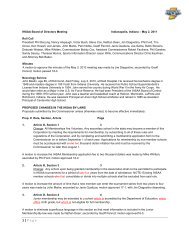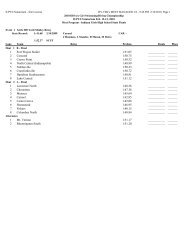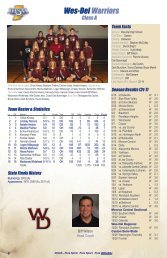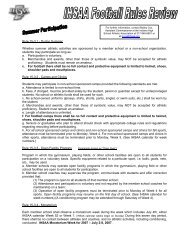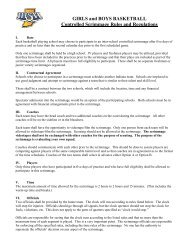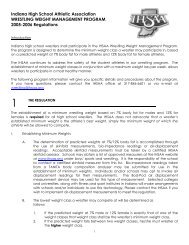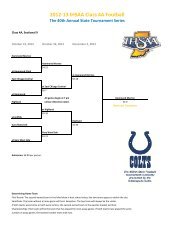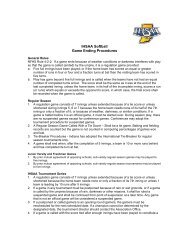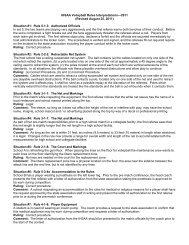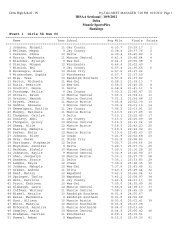NFHS Element Clarifications NFHS Gymnastics Frequently ... - ihsaa
NFHS Element Clarifications NFHS Gymnastics Frequently ... - ihsaa
NFHS Element Clarifications NFHS Gymnastics Frequently ... - ihsaa
Create successful ePaper yourself
Turn your PDF publications into a flip-book with our unique Google optimized e-Paper software.
<strong>NFHS</strong> <strong>Element</strong> <strong>Clarifications</strong><br />
Last Update: February 14, 2011<br />
Vault<br />
#2.503 ½ on – 2/1 off = 10.0 (11/10/10)<br />
#4.504 Add to existing vault description – also ¼ - ¼ Front salto = 10.0 (2/14/11)<br />
#6.403 Round-off, flic flac with 1/1 on - repulsion off = 9.6 (1/14/11)<br />
#6.404 Round-off, flic flac with 1/1 on – ½ off = 9.8 (1/14/11)<br />
Uneven Bars<br />
#8.203 Toe-on underswing with 1/2 (180 degree) turn to clear support on same bar = Superior (12/12/10)<br />
#7.303 Facing inward – Stalder backward with release and counter movement forward in flight to hang on HB (Ray) =<br />
High Superior (1/14/11)<br />
Balance Beam<br />
#2.212 ring/stag-ring lp/jp at waist height = Superior (8/27/10)<br />
#2.412 ring/stag-ring lp/jp at head height = Bonus High Superior (8/27/10)<br />
Backward shoulder roll = medium (9/13/10)Forward shoulder roll = medium (9/13/10)<br />
#8.402 Jump backward (flic-flac take-off) with ½ twist (180°) to walkover forward (Onodi)=Bonus High Superior (1/3/11)<br />
#2.209 switch leg lp/jp 135 degrees w/wo ¼ (2/8/11)<br />
#2.309 switch leg lp/jp 180 degrees (2/8/11)<br />
#2.409a switch leg lp/jp 180 degrees w/1/4 to side split (2/8/11)<br />
#2.409b switch leg lp/jp 180 degrees to straddle pike (2/8/11)<br />
#2.409c switch leg lp/jp to ring at head height (2/8/11)<br />
Floor Exercise<br />
#1.112 ring/stag-ring lp/jp at wait height = Medium (8/27/10)<br />
#1.212 ring/stag-ring w/wo 1/2 at head height = Superior (8/27/10)#1.312 ring/stag-ring 1/1 at head height = High<br />
Superior (8/27/10)<br />
#9.303 A series of saltos, one of which is forward and one of which is backward = High Superior for the series (Note:<br />
saltos must be directly connected) = High Superior (9/6/10)<br />
#9.402 a. Series of whip saltos backward each with 1/1 twist (360°) = Bonus High Superior (1/6/11)<br />
b. Series of saltos backward each with 1/1 twist (360°) = Bonus High Superior (1/6/11)<br />
#1.4.06a Split jp 180° w/ 1½ = Bonus High Superior (1/19/11)<br />
#8.201 From take-off forward from one or both legs – salto sideward tucked, piked, or stretched = Superior (1/28/11)<br />
Last Update: January 31, 2011<br />
<strong>NFHS</strong> <strong>Gymnastics</strong><br />
<strong>Frequently</strong> Asked Questions<br />
EQUIPMENT<br />
1. Can the landing area on vaulting that is required in 2012 be 2 mats that equal 18 feet?<br />
Rule 6-1-3 NOTE<br />
Yes, the 18 feet may be padded with 2 mats. (11/20/10)<br />
SCORING<br />
1. If an element is completed (according to the technical requirements) but a fall occurs due to incorrect technique on<br />
that element, can credit be given in difficulty and bonus?<br />
Rule 4-1<br />
Credit may be given in the difficulty category but 0.2 BHS credit may not be awarded in the bonus category for a BHS<br />
that has a fall or spot during the element or immediately after the completion of the element. (9/22/10)
2. What is the deduction for gymnasts competing out of order and how is the deduction taken?<br />
Rule 5-1-6g<br />
The deduction is 1.0 per event, regardless of the number of gymnasts who are out of order, taken by the meet referee<br />
from the final team score. (1/14/11)<br />
3. How many times may the Chief Judge deduct 0.2 for giving specific information to the gymnast on what to do during<br />
the routine (without warning)?<br />
Rule 6-5-2g, 7-3-7h, 8-3-7h, 9-3-7i<br />
Regardless of the number of cues given, the deduction is taken only once per event. (1/14/11)<br />
GENERAL DEDUCTIONS<br />
1. What is the deduction for 4 steps and a fall on any event?<br />
Rule 6-4-4, 7-3-4, 8-3-4, 9-3-4<br />
Deduct 0.5 for the fall and do not deduct for each step. (11/20/10)<br />
2. What is the deduction if a gymnast lands in a lunge after a tumbling pass and then steps backward?<br />
Page 94<br />
If a gymnast has a “controlled” landing at the end of a pass which lands in a lunge and then steps backward, there is<br />
no deduction. (1/6/11)<br />
3. What procedure is used when an element is completed but then is followed by a fall?<br />
Rule 4-1-2E<br />
If an element is completed (according to the technical requirements) but then is followed by a fall due to incorrect<br />
technique on that element, credit may be given in the difficulty category but 0.2 may not be awarded in the bonus<br />
category for a BHS. Note: BHS’s require that no fall occur after the completion of the element. (1/6/11)<br />
4. When should scoring begin after a gymnast falls on bars or beam?<br />
Rule 7-2-3 & 4, 7-2-1 After a fall, scoring shall resume when the gymnast restarts her exercise with an element that<br />
is listed in the book. On beam, scoring shall resume when the gymnast begins her first move after remounting.<br />
(1/6/11)<br />
5. What is the deduction if a gymnast is tugs on her leotard, brushes her hair off her face or wears nail polish that is<br />
distracting?<br />
Rule 6-3-1 through 4, 7-3-4, 8-3-4, 9-3-4<br />
Although there is no specific deduction regarding tugging on the leotard, brush of hair or nail polish, each of these<br />
may negatively affect how a judge evaluates the execution of an individual’s exercise. Execution is defined as the<br />
performance of an exercise with assurance and perfection in form and technique. Anything that detracts from the<br />
perfection of performance is a fault and may receive a deduction. What is distracting to one judge may not be<br />
distracting to another judge. If tugging on the leotard, brushing of the hair or wearing distracting nail polish negatively<br />
influences a judge in her Execution deductions, then a deduction may not also be taken in Artistry. Deducting for<br />
Artistry should be reserved for displaying poor quality of movement which reflects the personal style and the quality of<br />
expression of the gymnast. (1/14/11)<br />
VAULT<br />
1. On vault, what should the CJ do if a gymnast begins to vault without the signal?<br />
Rule 6-2-5b and 6-5-2k<br />
If the gymnast starts the exercise before the signal is given, she should be asked to stop and repeat the performance<br />
immediately. (8/26/10)<br />
2. If a gymnast vaults before the signal, is that considered one of the three attempts?<br />
Rule 6-2-5<br />
A gymnast is allowed a total of 3 attempts to do 2 vaults. If the gymnast vaults before the CJ signal, it is considered<br />
attempt number 1. The gymnast would have 2 more attempts. (11/20/10)<br />
3. Can a ¼ - ¾ twist in either direction?<br />
Rule 6-6-2<br />
Yes the twist may be either direction. (1/28/11)<br />
UNEVEN BARS<br />
1. On the uneven bars, in composition, what are considered uncharacteristic elements?<br />
Rule 7-3-3c<br />
Uncharacteristic elements include: a 1/2 turn on feet on the bar, jumping to a support on the HB, climbing or crawling
onto the bar, a leg cut that is not simultaneous, swings of no value (excludes extra swings), a scale, a v-sit, a skin-thecat<br />
or any other odd movement. (8/26/10)<br />
2. On the uneven bars, is there a deduction for stopping?<br />
Rule 7-3-4 No, there isn't a deduction for stopping. The deduction is: poor rhythm in elements/connections, each<br />
up to 0.1. (8/26/10)<br />
3. On the uneven bars, does a cast that is not within 20° of vertical receive Value Part credit?<br />
Rule 7-4 Figure 1<br />
A cast that is not within 20 degrees of vertical does not receive VP credit. (9/6/10)<br />
4. On the uneven bars, is following sequence of 2 back-to-back superiors, long hang kip + cast 45 degrees + giant +<br />
giant + tuck flyaway broke by the short cast?<br />
Rule 7-4<br />
A cast that does not go to vertical does not break the sequence of 2 back-to-back superiors. (9/6/10)<br />
5. On the uneven bars, is a long hang kip, push away, long hang kip a back-to-back superior?<br />
Rule 1-Definitions<br />
The 2 long hang kips are superiors that are directly connected. The push away is actually an attempt to cast to the<br />
second long hang kip. It does not break the connection between the 2 long hang kips. (9/6/10)<br />
6. What is the penalty if an element ends in a dead hang and the gymnast uses extra swings to regain momentum?<br />
Rule 7-3-4c<br />
If an element is performed poorly and it ends in a dead hang, a maximum deduction of 0.6 is taken for the extra<br />
swings that the gymnast uses to create momentum. More than 2 consecutive extra swings are not penalized. If there<br />
are more than 2 consecutive extra swings, only deduct for 2 extra swings which equals. 0.6. It is possible to take the<br />
extra swing deduction on several elements in a routine. The only restriction is that no more than 2 consecutive extra<br />
swings should be taken on a single element. If the gymnast then continues on and does another element and does<br />
an extra swing, then a 0.3 deduction would be taken. If the gymnast continues on after that and does 2 consecutive<br />
extra swings on a single element, the maximum deduction for that element is 0.6. (11/24/10)<br />
7. If a gymnast does a long hang kip mount (#1.208), and then performs two long hang kips within the routine can she<br />
receive superior credit for all three kips?<br />
Rule 7-5<br />
<strong>Element</strong>s are different if a mount element is performed as an element within the routine. (11/20/10)<br />
8. What is the deduction for pump swings used to create momentum after a fall?<br />
Page 92 #2<br />
After a fall, the gymnast is allowed to jump (or be lifted) to the high bar and then take a maximum of two pump swings<br />
to initiate momentum to resume the exercise. If more than two pump swings are taken, a 0.3 deduction for each extra<br />
swing(s) would be applied. (11/24/10)<br />
9. Does a glide ½ turn glide kip, within a routine (not the mount), fulfill the LA twist/turn?<br />
Rule 7-2-2b<br />
Yes. The mount and dismount may not be used to fulfill the LA twist/turn event requirement. (1/6/11)<br />
10. Why isn’t an uprise to front support listed in the new rule book?<br />
<strong>Element</strong> #3.303<br />
An uprise is complete when it reaches a clear support position. A clear support position consists of the hips away<br />
from the bar, the arms straight and the shoulders above the bar. At the completion of an uprise, the body could pass<br />
through a front support but most gymnasts do a clear back hip circle out of an uprise and some weaker gymnasts may<br />
do just a back hip circle out of an uprise. Stopping in a front support is unlikely because that runs counter to the<br />
current trend of a bar routine swinging from element to element. The superior uprise element in the previous book<br />
was deleted because it is not an actual element but is a poorly performed uprise. Additionally, if an attempt at an<br />
uprise is performed so poorly that the arms are bent and the gymnast pulls into the bar and does a circle around her<br />
stomach or chest, only credit for the back hip circle should be given. No credit is given for the movement prior to the<br />
back hip circle and the appropriate execution deductions should be taken for poor body position. As the book was<br />
recodified last year, elements and descriptions that were not technically correct were removed. (1/6/11)<br />
11. Can a bail (#8.304a & b) on bars count for a direction change and the LA twist/turn?<br />
Rule 7-2-2b & 7-3-3c<br />
Yes. A bail is an element of value that twists and moves in the opposite direction. (1/14/11)
12. What is a bar change?<br />
Rule 7-3-3b<br />
During a routine, if a gymnast moves from one bar to another bar to continue the routine, that is considered one bar<br />
change. For example, if a gymnast starts on the LB, she must move to the HB for 1 bar change and she must move<br />
to the LB for a 2 nd bar change. (1/28/11)<br />
13. Is a swing ½ turn a direction change on bars?<br />
Rule 1<br />
No. A direction change is defined as the body turning/twisting and moving in the opposite direction within an element<br />
of value. (1/28/11)<br />
14. What is the deduction if a gymnast falls on the bars?<br />
Rule 7-3-4d & p. 92<br />
If there is a fall on the bars, a .5 deduction is taken. The gymnast may take 2 pump swings to<br />
get started again without penalty. If more than 2 pump swings are taken then a .3 deduction is taken for each<br />
additional swing. (1/31/11)<br />
BALANCE BEAM<br />
1. What is the value of a ring/stag–ring leap/jump on balance beam or floor exercise?<br />
Balance Beam--Rule 8-6-2<br />
#2.212 ring/stag-ring lp/jp at waist height = Superior (8/27/10)<br />
#2.412 ring/stag-ring lp/jp at head height = Bonus High Superior (8/27/10)<br />
2. On beam, what is the value of a backward shoulder roll and a forward shoulder roll?<br />
Rule 8-6-7<br />
Although the rule book states a “backward roll with hand support” or “forward roll with hand support”, the book does<br />
not restrict the roll’s performance to over the head. Therefore, a back shoulder roll or forward shoulder roll are<br />
considered medium elements. Both rolls could be used to fulfill the forward or backward direction requirement.<br />
(9/13/10)<br />
3. On beam, which direction, forward or backward, does a tic-toc fulfill? Rule 8-3-3b<br />
A tic-toc may fulfill either a forward or backward direction. (11/20/10)<br />
4. What is the value of a Schuschunova on beam?<br />
<strong>Element</strong> #2.308<br />
The note at the bottom of the chart on page 60 states that leaps and jumps to prone/back hip circle shall be evaluated<br />
consistent with the root jump/leap. A Schuschunova ends in a prone and is most like #2.308 and will be valued at a<br />
high superior. (1/6/11)<br />
5. Can the legs be in any position during a handstand pirouette? Also, can a handstand count if it is within 20° of<br />
vertical?<br />
<strong>Element</strong> #6.101<br />
Handstands on beam and floor can have the legs in any position, i.e., stag, together, straddled. The body, torso, must<br />
be in the vertical and it must be a technically correct vertical. The handstand must be held for 2 seconds to receive<br />
Value Part credit. The handstand must be in the vertical position. Twenty degrees of vertical is not acceptable.<br />
(1/6/11)<br />
6. Can the dismount be used as one of the two required directions on beam?<br />
8-3-3b<br />
The dismount may not be used for one of the two required directions on beam. (1/6/11)<br />
7. What is the value of a switch wolf on beam?<br />
Page 97-7d, <strong>Element</strong> #2.203<br />
The value of a switch wolf is the same as a wolf jump on beam which is a superior. (1/14/11)<br />
FLOOR EXERCISE<br />
1. What is the value of a ring/stag–ring leap/jump on balance beam or floor exercise?<br />
Floor Exercise--Rule 9-6-1<br />
#1.112 ring/stag-ring lp/jp at wait height = Medium (8/27/10)<br />
#1.212 ring/stag-ring w/wo 1/2 at head height = Superior (8/27/10)
#1.312 ring/stag-ring 1/1 at head height = Bonus High Superior (8/27/10)<br />
2. On floor exercise, can two 4 inch landing mats be used in place of one 8 inch skill cushion?<br />
Rule 9-1-5a<br />
Up to 2 manufactured mats may be placed separately on the floor exercise area. (8/26/10)<br />
3. On floor exercise, is a switch side leap, directly connected to a straddle jump considered two different shapes?<br />
Rule 1-Definitions<br />
A switch side leap and a straddle jump are the same shape. (8/26/10)<br />
4. On floor exercise, what is the value of a series of saltos?<br />
Rule 9-6-8 & 9<br />
A series of saltos, one of which is forward and one of which is backward = High Superior for the series (9/6/10)<br />
5. On floor exercise, does a split leap directly connected to a switch leap fulfill an event requirement?<br />
Rule 9-2-3<br />
No, the event requirement states that it must be a dance series of 2 different shapes. A split leap is a split shape and<br />
a switch leap is a split shape. (9/6/10)<br />
6. On floor exercise, a gymnast performs 3 passes: Pass #1 - round-off, back handspring, layout salto with a full twist,<br />
Pass #2 – front handspring to layout front salto, Pass #3 – round-off back handspring tuck back salto. In addition, at<br />
the end of her routine she does a dive forward roll. Is the gymnast penalized for ending the exercise with a medium<br />
acro element?<br />
Rule 9-2-3<br />
A gymnast is not penalized for ending with a medium acro element if she completed a superior acro element in her<br />
third acro pass. (9/6/10)<br />
7. On floor exercise, what is the value of the following combination: tuck front salto, round-off, stretched back salto?<br />
Rule 9-6-8 & 9<br />
Each salto would be a superior value part. This combination could receive BBS. However, this combination is not<br />
considered a series of saltos, one forward and one backward, because the round-off breaks the direct connection.<br />
(9/20/10)<br />
8. Can a turn be used as the dance in the dance/acro series on floor exercise?<br />
Rule 9-2-3b<br />
Yes a turn may be used as the dance in the dance/acro. (11/20/10)<br />
9. What shape is a sissone on floor?<br />
Rule 1<br />
A sissone is a split shape. (11/20/10)<br />
10. What shape is a Strug on floor?<br />
Rule 1<br />
A Strug is a split shape. (11/20/10)<br />
11. Is a tuck jump the same shape as a wolf jump?<br />
Rule 1<br />
A tuck jump and a wolf jump are different shapes. (1/6/11)<br />
12. How do you determine the shape of a leap or jump on floor?<br />
Rule 1<br />
The shape of a leap or jump is determined at the apex (highest point) to the finish (landing). (1/6/11)<br />
13. Can a high superior or bonus high superior be used for the event requirement of a superior acro element in the 3 rd<br />
acro pass or as the last acro element?<br />
9-2-3a<br />
Yes a high superior or bonus high superior may be used for the event requirement of a superior acro element in the<br />
3 rd acro pass or as the last acro element. Rule 9-2-3a states a “superior” acro element which is the minimum<br />
required. (1/6/11)<br />
14. Can the acro direction requirement in composition have a deduction of one-half tenth for only part of the requirement<br />
missing?
9-3-3b<br />
The composition requirement for requiring a backward acro element as well as a forward or sideward acro element is<br />
a flat 0.1. No half tenths may be used. (1/6/11)<br />
15. Can a handstand full pirouette, step down, kick back up into another handstand full pirouette be given back-to-back<br />
superior credit?<br />
Rule 1<br />
The combination of elements is a BBS if the gymnast steps down on the right foot and swings the left foot through and<br />
steps on the left swinging the right one up into the next handstand. This counts since the free leg is the take-off leg<br />
for the next element. Rhythm deductions are possible in this combination if the connecting swing of the take-off leg<br />
into the 2 nd handstand is too high (above 45 degrees) resulting in a pause/break of the series. Even if the series is not<br />
broken, it is possible that the series will have a rhythm deduction. (1/6/11)<br />
16. Why isn’t a barani listed in the rule book?<br />
<strong>Element</strong> #8.201, 8.202, 8.301<br />
The term “barani” is used differently in different regions of the country. In some regions a barani refers to a dismount<br />
off of balance beam. In other regions the word barani is loosely used to describe a tumbling move on floor exercise.<br />
The origin of a barani began on the trampoline and was used as a method of twisting a front salto from a two foot take<br />
off. A barani is no longer listed in the rulebook because it is not an element but rather a technique used to perform a<br />
front salto with a ½ twist. A barani is not an aerial roundoff because all aerials take off of one foot. The barani<br />
technique involves a two foot take off whereas an aerial roundoff is a 1 foot take off. The twist on the front with a ½<br />
twist, using the barani technique, occurs early. Therefore, a tucked or piked front with a ½ twist using the barani<br />
technique of twisting early is most closely identified with elements #8.201 or #8.202 on floor exercise and would<br />
receive superior credit. A stretched front with a ½ twist would be #8.301 and would be a high superior. (1/14/11)<br />
17. Can a roundoff flip flop, flip flop straddle jump count as both a tumbling pass and the dance/acro series event<br />
requirements?<br />
Rule 1<br />
Credit for a tumbling series and the dance/acro series may not overlap. A roundoff flip flop, flip flop tuck back salto to<br />
straddle jump may count for both a tumbling pass and the dance/acro series event requirements because there are<br />
enough elements (5) to fulfill both series without overlapping. (1/14/11)<br />
18. What direction is an aerial roundoff?<br />
Rule 9-3-3b, <strong>Element</strong> #7.201b<br />
An aerial roundoff may be considered a sideward direction. (1/14/11)<br />
19. Can an aerial roundoff be used to fulfill the 180° twist event requirement?<br />
<strong>Element</strong> #7.201b<br />
No. An aerial roundoff initiates a twist by dipping the shoulder and twisting the body while the push foot is still in<br />
contact with the floor. The 180° twist requires the twist to be initiated and completed in the air. (1/14/11)<br />
20. If a front salto/aerial to a sitting position (#7.102) is a medium, would a back salto to a prone position be a medium.<br />
<strong>Element</strong> #7.102<br />
Yes. Both are not considered saltos that land on 2 feet. (1/14/11)<br />
21. hat is the value of a switch wolf on FX?<br />
Page 92-7d, <strong>Element</strong> #1.103<br />
A switch wolf is a medium. (1/14/11)<br />
22. If a gymnast performs as side somie, is she allowed to bring her feet together to do a straddle jump in order to get<br />
BBS?<br />
Rule 1<br />
The side sommie to a straddle jump would connect for a mixed series as long as the 2 elements are connected like<br />
any other 2 elements are connected. That is, if the side sommie lands on 2 feet the gymnast must immediately take<br />
off of 2 feet. If the side sommie lands on 1 foot, the other foot must land right beside the first foot in order to take off<br />
from 2 feet. Once a foot lands it cannot move again. (1/28/11)
IHSAA <strong>Gymnastics</strong> Rules Interpretations<br />
Balance Beam<br />
Page 92, Points of Emphasis, #7. d:<br />
A switch-leg leap to wolf position has the same value as a wolf jump.<br />
#2.209 switch leg lp/jp 135 degrees w/wo ¼<br />
#2.309 switch leg lp/jp 180 degrees<br />
#2.409a switch leg lp/jp 180 degrees w/1/4 to side split<br />
#2.409b switch leg lp/jp 180 degrees to straddle pike<br />
#2.409c switch leg lp/jp to ring at head height<br />
Clarification: A handstand (Group 6) MAY NOT be used in composition as an acro element of direction when considering<br />
the lack of a backward and forward or sideward acro element under spacing and direction because it does not pass<br />
through vertical. Group 5 is designated as dance holds. Group 6 is not dance. Thus, a handstand MAY be used to fulfill<br />
the event requirements as part of an acro series or a mixed series as long as the handstand reaches vertical and is held<br />
for 2 seconds.<br />
Floor<br />
Page 92, Points of Emphasis, #7. d:<br />
A switch-leg leap to wolf position has the same value as a wolf jump.<br />
Revised 2-29-11<br />
Each of the following are different shapes:<br />
The following are considered different shapes: tuck, cat, pike, wolf, split, straddle, ring, sheep, and stretched. A switch<br />
leg leap takes on the shape of what happens after the switch. Examples, switch leg leap is considered a split leap. A<br />
switch wolf is considered a wolf. A switch to side straddle is considered a straddle. A schushnova is considered a<br />
straddle. A tour jete is considered a split.<br />
The floor exercise event requirement of tumbling in 2 directions has been deleted. The lack of an acro element, within a<br />
pass, in each of two directions (one must be backward and another must be forward or sideward) is now under<br />
composition (pg 75, Rule 9-3-b.). A pass is defined as a minimum of three directly connected acro elements. Thus, a<br />
dance-acro or acro-dance series would not fulfill this requirement.<br />
Page 92, Section 5, letter B:<br />
An Arabian walkover and Arabian salto are considered forward in direction. Page 92, Section 5, letter B



